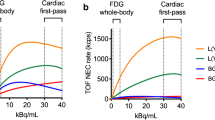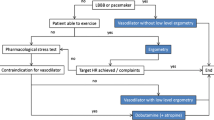Abstract
Purpose
Peptides containing the asparagine-glycine-arginine (NGR) motif bind to aminopeptidase N (CD13), which is expressed on inflammatory cells, endothelial cells, and fibroblasts. It is unclear whether radiolabeled NGR-containing tracers could be used for in vivo imaging of the early wound-healing phase after myocardial infarction (MI) using positron emission tomography (PET).
Procedures
Uptake of novel tracer [68Ga]NGR was assessed together with [68Ga]arginine-glycine-aspartic acid ([68Ga]RGD) and 2-deoxy-2-[18 F]fluoro-d-glucose after myocardial ischemia/reperfusion (MI/R) injury using μ-PET and autoradiography, and relative expressions of CD13 and integrin β3 were assessed in fibroblasts, inflammatory cells, and endothelial cells by immunohistochemistry.
Results
In the infarcted myocardium, uptake of [68Ga]NGR was maximal from days 3 to 7 after MI/R, and correlated with fibroblast and inflammatory cell infiltration as well as [68Ga]RGD uptake.
Conclusions
[68Ga]NGR allows noninvasive and sequential determination of CD13 expression in fibroblasts and inflammatory cells by PET. This will facilitate monitoring of CD13 in the individual wound healing processes, allowing patient-specific therapies to improve outcome after MI.






Similar content being viewed by others
Abbreviations
- MI:
-
Myocardial infarction
- LV:
-
Left ventricular
- NGR:
-
Asparagine-glycine-arginine
- RGD:
-
Arginine-glycine-aspartic acid
- [18 F]FDG:
-
2-Deoxy-2-[18 F]fluoro-d-glucose
- P4H:
-
Prolyl-4-hydroxylase β
- PET:
-
Positron emission tomography
- NOTA:
-
1,4,7-Triazacyclononane-1,4,7-triacetic acid
References
Frangogiannis NG (2012) Regulation of the inflammatory response in cardiac repair. Circ Res 110:159–173
Virag JI, Murry CE (2003) Myofibroblast and endothelial cell proliferation during murine myocardial infarct repair. Am J Pathol 163:2433–2440
Fraccarollo D, Galuppo P, Bauersachs J (2012) Novel therapeutic approaches to post-infarction remodelling. Cardiovasc Res 94:293–303
Bengel FM, George RT, Schuleri KH et al (2013) Image-guided therapies for myocardial repair: concepts and practical implementation. Eur Heart J Cardiovasc Imaging 14:741–751
Gaertner FC, Kessler H, Wester HJ et al (2012) Radiolabelled RGD peptides for imaging and therapy. Eur J Nucl Med Mol Imaging 39(Suppl 1):S126–S138
van den Borne SWM, Isobe S, Verjans JW et al (2008) Molecular Imaging of interstitial alterations in remodeling myocardium after myocardial infarction. J Am Coll Cardiol 52:2017–2028
Pichler BJ, Kneilling M, Haubner R et al (2005) Imaging of delayed-type hypersensitivity reaction by PET and 18 F-galacto-RGD. J Nucl Med 46:184–189
Cao Q, Cai W, Li ZB et al (2007) PET imaging of acute and chronic inflammation in living mice. Eur J Nucl Med Mol Imaging 34:1832–1842
Pasqualini R, Koivunen E, Kain R et al (2000) Aminopeptidase N is a receptor for tumor-homing peptides and a target for inhibiting angiogenesis. Cancer Res 60:722–727
Oostendorp M, Douma K, Wagenaar A et al (2010) Molecular magnetic resonance imaging of myocardial angiogenesis after acute myocardial infarction. Circulation 121:775–783
Buehler A, van Zandvoort MAMJ, Stelt BJ et al (2006) cNGR: a novel homing sequence for CD13/APN targeted molecular imaging of murine cardiac angiogenesis in vivo. Arterioscler Thromb Vasc Biol 26:2681–2687
Mina-Osorio P, Winnicka B, O'Conor C et al (2008) CD13 is a novel mediator of monocytic/endothelial cell adhesion. J Leukoc Biol 84:448–459
Pereira FE, Cronin C, Ghosh M et al (2013) CD13 is essential for inflammatory trafficking and infarct healing following permanent coronary artery occlusion in mice. Cardiovasc Res 100:74–83
Look AT, Ashmun RA, Shapiro LH, Peiper SC (1989) Human myeloid plasma membrane glycoprotein CD13 (gp150) is identical to aminopeptidase N. J Clin Investig 83:1299–1307
Reilkoff RA, Bucala R, Herzog EL (2011) Fibrocytes: emerging effector cells in chronic inflammation. Nat Rev Immunol 11:427–435
Pilling D, Fan T, Huang D et al (2009) Identification of markers that distinguish monocyte-derived fibrocytes from monocytes, macrophages, and fibroblasts. PLoS ONE 4:e7475
Atherton AJ, Monaghan P, Warburton MJ, Gusterson BA (1992) Immunocytochemical localization of the ectoenzyme aminopeptidase N in the human breast. J Histochem Cytochem 40:705–710
Lai A, Ghaffari A, Ghahary A (2010) Inhibitory effect of anti-aminopeptidase N/CD13 antibodies on fibroblast migration. Mol Cell Biochem 343:191–199
Ghaffari A, Li Y, Kilani RT, Ghahary A (2010) 14-3-3 sigma associates with cell surface aminopeptidase N in the regulation of matrix metalloproteinase-1. J Cell Sci 123:2996–3005
Petrovic N, Schacke W, Gahagan JR et al (2007) CD13/APN regulates endothelial invasion and filopodia formation. Blood 110:142–150
Matteo PD, Arrigoni GL, Alberici L et al (2011) Enhanced expression of CD13 in vessels of inflammatory and neoplastic tissues. J Histochem Cytochem 59:47–59
Frantz S, Adamek A, Fraccarollo D et al (2009) The eNOS enhancer AVE 9488: a novel cardioprotectant against ischemia reperfusion injury. Basic Res Cardiol 104:773–779
Leal S, Diniz C, Sa C et al (2006) Semiautomated computer-assisted image analysis to quantify 3,3′-diaminobenzidine tetrahydrochloride-immunostained small tissues. Anal Biochem 357:137–143
Menichetti L, Kusmic C, Panetta D et al (2013) MicroPET/CT imaging of αvβ3 integrin via a novel 68Ga-NOTA-RGD peptidomimetic conjugate in rat myocardial infarction. Eur J Nucl Med Mol Imaging 40:1265–1274
Guendjev Z (1977) Experimental myocardial infarction of the rat and stimulation of the revascularization by the flavonoid drug crataemon. Arzneimittelforschung 27:1576–1579
Mollmann H, Nef HM, Kostin S et al (2006) Bone marrow-derived cells contribute to infarct remodelling. Cardiovasc Res 71:661–671
Lee WW, Marinelli B, van der Laan AM et al (2012) PET/MRI of inflammation in myocardial infarction. J Am Coll Cardiol 59:153–163
Reshef A, Shirvan A, Akselrod-Ballin A, Wall A, Ziv I (2010) Small-molecule biomarkers for clinical PET imaging of apoptosis. J Nucl Med 51:837–840
Dilsizian V, Zynda TK, Petrov A et al (2012) Molecular imaging of human ACE-1 expression in transgenic rats. JACC Cardiovasc Imaging 5:409–418
Su H, Spinale FG, Dobrucki LW et al (2005) Noninvasive targeted imaging of matrix metalloproteinase activation in a murine model of postinfarction remodeling. Circulation 112:3157–3167
Wu JC, Chen IY, Wang Y et al (2004) Molecular imaging of the kinetics of vascular endothelial growth factor gene expression in ischemic myocardium. Circulation 110:685–691
Dijkgraaf I, Van de Vijver P, Dirksen A, Hackeng TM (2013) Synthesis and application of cNGR-containing imaging agents for detection of angiogenesis. Bioorg Med Chem 21:3555–3564
Curnis F, Arrigoni G, Sacchi A et al (2002) Differential binding of drugs containing the NGR motif to CD13 isoforms in tumor vessels, epithelia, and myeloid cells. Cancer Res 62:867–874
Ozawa MG, Zurita AJ, Dias-Neto E et al (2008) Beyond receptor expression levels: the relevance of target accessibility in ligand-directed pharmacodelivery systems. Trends Cardiovasc Med 18:126–132
Chen K, Ma W, Li G et al (2013) Synthesis and evaluation of 64Cu-labeled monomeric and dimeric NGR peptides for MicroPET imaging of CD13 receptor expression. Mol Pharm 10:417–427
Notni J, Pohle K, Wester HJ (2013) Be spoilt for choice with radiolabelled RGD peptides: preclinical evaluation of (6)(8)Ga-TRAP(RGD)(3). Nucl Med Biol 40:33–41
Meoli DF, Sadeghi MM, Krassilnikova S et al (2004) Noninvasive imaging of myocardial angiogenesis following experimental myocardial infarction. J Clin Investig 113:1684–1691
Higuchi T, Bengel FM, Seidl S et al (2008) Assessment of alphavbeta3 integrin expression after myocardial infarction by positron emission tomography. Cardiovasc Res 78:395–403
Sherif HM, Saraste A, Nekolla SG et al (2012) Molecular imaging of early αvβ3 integrin expression predicts long-term left-ventricle remodeling after myocardial infarction in rats. J Nucl Med 53:318–323
Dimastromatteo J, Riou LM, Ahmadi M et al (2010) In vivo molecular imaging of myocardial angiogenesis using the αvβ3 integrin-targeted tracer 99mTc-RAFT-RGD. J Nucl Cardiol 17:435–443
Verjans J, Wolters S, Laufer W et al (2010) Early molecular imaging of interstitial changes in patients after myocardial infarction: comparison with delayed contrast-enhanced magnetic resonance imaging. J Nucl Cardiol 17:1065–1072
Makowski MR, Ebersberger U, Nekolla S, Schwaiger M (2008) In vivo molecular imaging of angiogenesis, targeting alphavbeta3 integrin expression, in a patient after acute myocardial infarction. Eur Heart J 29:2201–2201
Razavian M, Marfatia R, Mongue-Din H et al (2011) Integrin-targeted imaging of inflammation in vascular remodeling. Arterioscler Thromb Vasc Biol 31:2820–2826
Acknowledgments
We gratefully acknowledge Annette Berbner, Charlotte Dienesch, Paula Arias, Katja Hirsch, and Annemieke Klan for expert technical assistance. This work was supported by grants from the Interdisciplinary Clinical Research Center Würzburg (to J.T., J.B. and S.S.: IZKF E-140).
Conflict of interest
The authors declare no conflict of interest.
Author information
Authors and Affiliations
Corresponding author
Additional information
The authors take responsibility for all aspects of the reliability and freedom from bias of the data presented and their discussed interpretation.
Electronic supplementary material
Below is the link to the electronic supplementary material.
ESM 1
(PDF 5895 kb)
Rights and permissions
About this article
Cite this article
Tillmanns, J., Schneider, M., Fraccarollo, D. et al. PET Imaging of Cardiac Wound Healing Using a Novel [68Ga]-Labeled NGR Probe in Rat Myocardial Infarction. Mol Imaging Biol 17, 76–86 (2015). https://doi.org/10.1007/s11307-014-0751-2
Received:
Revised:
Accepted:
Published:
Issue Date:
DOI: https://doi.org/10.1007/s11307-014-0751-2




